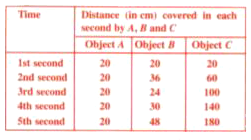An object moves with constant acceleration a. Which of the following expressions are also constant?
d|v|dt
∣∣∣dvdt∣∣∣
d(v2)dt
d(v|v|)dt
The correct Answer is:B
To solve the problem, we need to analyze the motion of an object moving with constant acceleration a and determine which of the given expressions are also constant.
1. Understanding Constant Acceleration:
- When an object moves with constant acceleration a, it means that the acceleration does not change over time. This implies that the rate of change of velocity is uniform.
2. Expression for Acceleration:
- The acceleration a can be expressed mathematically as:
a=dVdt
- Since a is constant, this means that dVdt is also constant.
3. Magnitude of Acceleration:
- The magnitude of acceleration |a| is also constant because it is given that acceleration a is constant.
4. Velocity and Its Derivative:
- The velocity V of the object can change over time, but since the acceleration is constant, the change in velocity ΔV over a time interval Δt will be linear.
- Therefore, dVdt is constant, but V itself is not constant.
5. Other Expressions:
- The expression d|V|dt (the rate of change of the magnitude of velocity) is also constant because the acceleration is constant.
- However, expressions like dV2dt or dV|V| will not be constant since they depend on the changing velocity V.
6. Conclusion:
- The only expression that remains constant is dVdt (or the acceleration) and the magnitude of acceleration |a|.
Final Answer:
The expressions that are constant are:
- |a| (magnitude of acceleration)
- dVdt (acceleration)
- When an object moves with constant acceleration a, it means that the acceleration does not change over time. This implies that the rate of change of velocity is uniform.
- The acceleration a can be expressed mathematically as:
a=dVdt
- Since a is constant, this means that dVdt is also constant.
- The magnitude of acceleration |a| is also constant because it is given that acceleration a is constant.
- The velocity V of the object can change over time, but since the acceleration is constant, the change in velocity ΔV over a time interval Δt will be linear.
- Therefore, dVdt is constant, but V itself is not constant.
- The expression d|V|dt (the rate of change of the magnitude of velocity) is also constant because the acceleration is constant.
- However, expressions like dV2dt or dV|V| will not be constant since they depend on the changing velocity V.
- The only expression that remains constant is dVdt (or the acceleration) and the magnitude of acceleration |a|.
The expressions that are constant are:
- |a| (magnitude of acceleration)
- dVdt (acceleration)
Topper's Solved these Questions
- BOOK - DC PANDEY ENGLISHCHAPTER - KINEMATICSEXERCISE - More Than One Correct6videos
KINEMATICS
- BOOK - DC PANDEY ENGLISHCHAPTER - KINEMATICSEXERCISE - Comprehension7videos
KINEMATICS
- BOOK - DC PANDEY ENGLISHCHAPTER - KINEMATICSEXERCISE - Objective45videos
KINEMATICS
- BOOK - DC PANDEY ENGLISHCHAPTER - GRAVITATIONEXERCISE - (C) Chapter Exercises45videos
GRAVITATION
- BOOK - DC PANDEY ENGLISHCHAPTER - KINEMATICS 1EXERCISE - INTEGER_TYPE15videos
KINEMATICS 1
Similar Questions
Knowledge Check
- Question 1 - Select One
When objects at different distances are seen by the eye, which of the following remains constant?
Athe focal length of the eyes lensBthe objects distance from the eye lensCthe radii of curvature of the eye lensDthe image distance from the eye lens
A body moves from rest with a constant acceleration. Which one of the following graphs represents the variation of its kinetic energy K with the distance travelled x?
View SolutionIf an object is moving with a constant acceleration, the net force acting on that body is
View SolutionWhich graph corresponds to an object moving with a constant negative acceleration and a positive velocity ?
View SolutionWhich graph corresponds to an object moving with a constant negative acceleration and a positive velocity ?
View SolutionThe initial position of an object at rest is given by 3ˆi−8ˆj. It moves with constant acceleration and reaches to the position 2ˆi+4ˆj after 4s. What is its acceleration ?
View SolutionThe table below shows the distance in cm, travelled by the objects A, B and C during each second. (i) Which object is moving with constant speed ?
Give a reason for your answer.
(ii) Which object is moving with a constant acceleration? Give a reason.
(iii) Which object is moving with irregular acceleration?
 View Solution
View SolutionWhen objects at different distances are seen by the eye, which of the following remain constant?
View Solution

